Reports are a crucial form of communication for any business. But what’s more important is preparing the right kind of report for the right cause.
Most people are not aware of the different types of business reports used in business communication along with their use cases.
Luckily this guide will help you out in increasing your awareness. Along with other reporting aspects such as its importance, characteristics and structure. But before that..
Overview of a Business Report?
A business report is a formal document used to communicate information in a systematic manner. The information includes statistics, facts, research analysis, arguments, recommendations, etc.
The content of a business report is unbiased and factual. It is presented in an orderly structure within a specific format. Business communication report writing serves as a way to bridge the gap between the lower and top levels of management. There are different types of business reports used for evaluating, reviewing, and analyzing specific events.
Must Read: Check out our detailed guide on, what is a business report, how to write one with examples
Characteristics of report writing are:
- Reports must be accurate.
- The information presented is clear and precise.
- Relevant information such as facts and figures.
- Written in an unambiguous style with simple language
- Business reports are objective and logical
Related Reading: Characteristics And Features of a Good Business Report
Classification of business reports:
A business report can be categorized in many forms depending on the need and requirement. The classification of the report helps set the right expectations and objectives for the business. Reports can be classified under 6 forms,
1) On the basis of function: Reports are categorized in terms of functions, as they can be used to inform and analyze.
2) On the basis of frequency & importance: Reports are prepared to be transmitted on a daily, weekly monthly, and annual basis. Some reports are needed on daily basis for moving with the regular operations of the company.
3) On the basis of subject matter: Business reports are associated with specific business operations, and discuss the subject matter.
4) On the basis of the level of formality: Business reports are also classified on the basis of formality and the tone used by the writer. At times reports can be prepared to communicate with a colleague using a conversational tone which represents an informal context in nature.
5) On the basis of length: Business reports range by length and the amount of information they provide. Short can be of few pages compared with a long report that provides a deeper analysis.
6) On the basis of purpose: Some kind of business reports are prepared to achieve specific objectives.
7) On the basis of the reader-writer relationship: Business reports can be prepared for the internal management team as well as for the people having a direct interest in the company. They are rather called external stakeholders.
8) On the basis of communication medium: The report can also be categorized in the manner in which the report is presented. Such as oral reports, written reports, etc
24 Different Types of Business Reports used by Organization
->On the basis of frequency or importance
The reports that fall under this category are routine reports and special reports.
1) Routine Report: A routine report is prepared at specific intervals or as a routine activity. The frequency of these reports can be daily, weekly, monthly, etc.
Examples of Routine Report
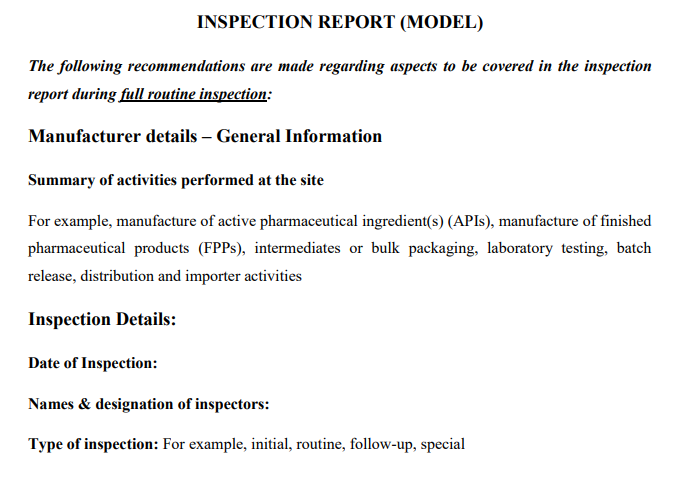
The above image is a real demonstration of a routine inspection report prepaired for a manufacturing firm with an inspection date and type of inspection inducted.
2) Non-routine: The organization prepares non-routine reports on special occasions. That is why non-routine reports are not required by the management on a daily basis and belong to special nature.
There are various kinds of non-routine reports for example Interview reports, Exception reports, Staff reports, etc are some of them.
3) Special Report: This kind of report is prepared for the management on special requests for a specific purpose. Typically, these kinds of reports include the recommendations and views of the report writer based on factual information.
->On the basis of legal formalities
These reports are used for legal activities and business obligations. They include:
3) Formal Report: A formal report is prepared in a predetermined and structured format. It focuses on deep detail and objectivity. No personal pronouns are used in this type of report.
Example of Formal Report

The above image is an example of real formal report drafted on the topic “Effect of stress on Business Employess” with introduction, statement of the problem and significance of the study.
4) Informal Report: An informal report is prepared in a letter or memo format. Usually, the informal business report consists of three elements that include an introduction, a body, and a conclusion. It uses casual language and can be addressed directly to the concerned person.
Example of Informal Report
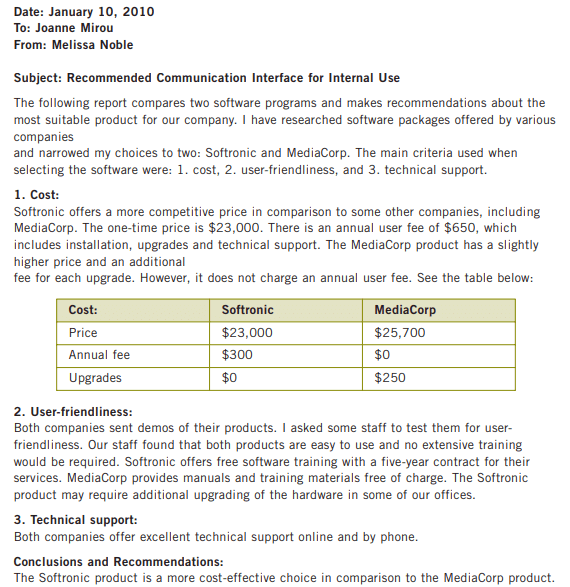
The above image is an real example of informal report written for top management, recommending the suitbale product for the company after comparing two differnt software.
Related Reading: Difference between formal report and informal report
5) Statutory Report: These are required by the law to be provided by a large company. The information provided includes share allotments, cash receipts, details of company board members, contact information, etc.
6) Non-Statutory Report: A non-statutory report is not required under the provisions of the law. However, it is used by the board of directors of a company to make important decisions. These reports are prepared for submission to shareholders, directors, committees, and employers.
->On the basis of function
Functional reports include the following types of reports in business:
7) Informational Report: An informational report is an objective report that only mentions facts without detailed explanations. Some examples of informational reports are attendance reports, annual budgets, and employee roles in the company. etc.
8) Analytical Report: This kind of business report is necessary for important decisions made by a company. It evaluates a company’s current standing and presents relevant conclusions, solutions, and suggestions. Examples – are scientific reports and employee appraisal reports.
The difference between an Analytical report and Informational report
Informational business reports are created for informing the reader about the current facts and data. The creator of the report collects, organizes, and represents the data without any interpretation. Informational reports can be prepared in a standardized format, such as a company Annual report as well as using an information tone.
Whereas an analytical report provides a details analysis of the information and data shared. The purpose of the analytical report is to explore the problem, evaluate the right solution, and provide justifiable recommendations. Information provided in the analytical report is supported with the help of, graphs, statistics, and illustrations.
Just like any other business report type, an Analytical report consist of three main parts.
- The Front Matter
- The Body Matter
- The End Matter

The above image represents part of the Analytical report in three structured formats. These include Report preliminaries, Report bodies, and Report supplements.
9) Progress Report: A progress report is used to track the development of a company. It follows progress being made in accordance with the goals set. This type of report can be daily, weekly, monthly, etc, and is used to track tasks from different departments.
Example of Progress Report
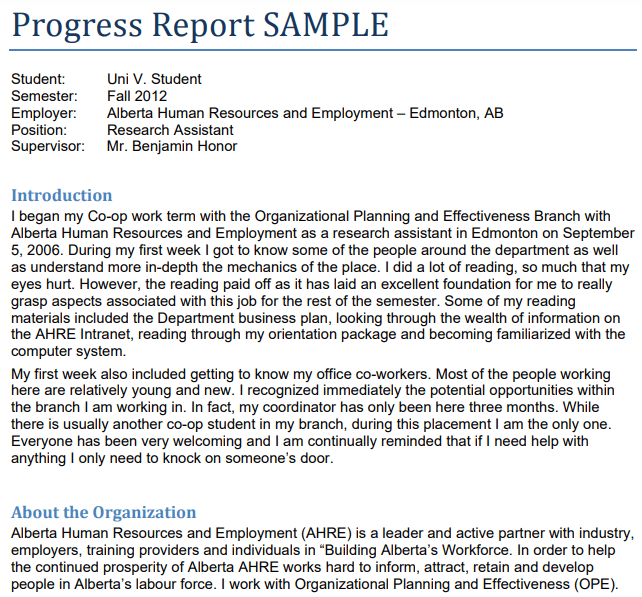
The above image is an sample of progress report prepaired by a student as a research assistant in a company.
10) Vertical Report: A vertical report follows a hierarchical structure with up or down movement within a company. It could be for the managers in an upward motion or mentees in a downward motion.
11) Lateral Report: On the other hand, lateral reports move from side to side. This report is shared between the same or similar departments of an organization. This helps in coordination and working on tasks in unison.
12) Recommendation report: Also referred to as justification report is prepared to provide useful recommendations to the management. The recommendation can be in the form of factual data that can help to solve complex problems.
The main purpose of the recommendation report is to assist in decision-making. It aims at solving specific problems with a recommended plan of action. Moreover, the report can also provide justification for management action. Such as justification for expansion, hiring new staff, purchasing assets, etc.
13) Feasibility report: This type of business report helps in validating the recommended alternatives present in the report. For any business, it is important to predict the outcome of the plan of action prepared.
Hence the basic purpose of a feasibility report is to help businesses make a corrective plan of action that facilitates decision-making. The writer of the report has to draft some major points within the report that is:
- The description of the writer’s decision.
- The problem addressed in the report,
- The reason for implementing the suggestion and the side effects.
- The resource required to implement the solution majorly, the time, and the cost.
14) Yardstick report: The yardstick report is for comparing and finding the right solution for the business. The term Yardstick refers to side-by-side comparison and framing analysis based on available data.
It helps business to validate multiple alternatives for solving problems and chose the best alternative as a plan of action. The essential of the Yardstick report includes:
- The problem statement with a brief description.
- The possible alternatives for solving the problems.
- The criteria to validate the multiple alternatives.
- The final conclusion with the selected alternatives.
->On the basis of length
There are various types of business reports that are lengthy and detailed, while others are short and concise. They are:
12) Long Report: These reports are written in a formal manner and consist of multiple pages. The content is heavily detailed and focuses on a wide range of data collected through investigation and research.
13) Short Report: As the name suggests, short reports are compact and concise. They are written in an informal manner, usually in the form of a letter or memorandum. Short reports can directly be addressed to the manager and do not require detailed information.
Template of Short Report
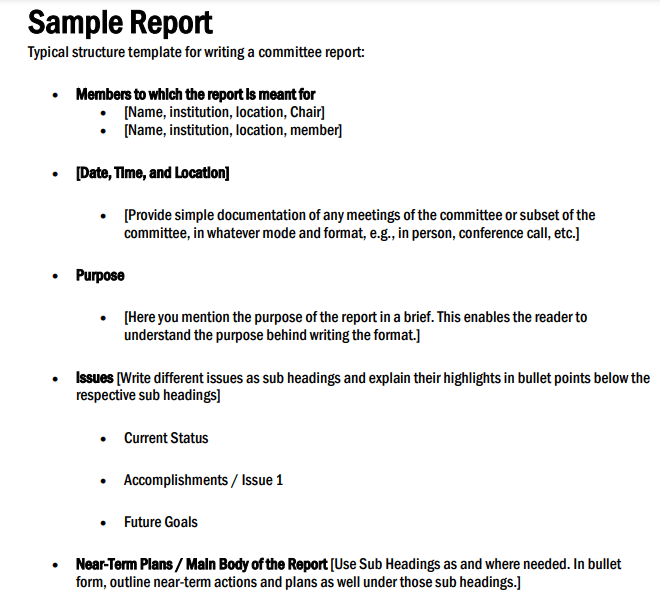
Related Readings: Short Report In Business Communication: (Format and Types Included)
->On the basis of purpose
These reports are written to carry out a specific objective. They include:
14) Research Report: A research report is the most detailed type of business reporting for any enterprise. It is made when a company wants to try something new or expand into a new geographical location.
It is made up of all the data collected by researchers and specialists. This includes market research, in-field studies, experiments, census, etc.
15) Explanatory Report: An explanatory report is written to explain a specific topic of interest to its readers. It is written in a clear and formal way which is easy to understand. Explanatory reports can be used to explain the findings of a research report.
-> On the basis of the subject matter
16) Sales report: The sales report is a special draft prepared to maintain records in a systematic manner. For any business, organization sales are one of the important functions.
There are many types of sales reports such as Call reports, expense reports, sales work plan reports, loss sales reports, etc. A record of sales should be maintained in order to measure the actual performance of the business.
Therefore sales report is prepared to evaluate crucial information related to sales. It holds information about the total number of sales during the financial year, the type of unit sold, the number of new customers, the cost of goods sold, etc. The creator of the sales report should keep the essentials in check, including
- The report should be concise with important information mentioned clearly.
- The report should include complete information about the sales recorded in the financial year.
- The data and facts should be accurate with no marginal error.
17) Market survey report: As the name suggests a market survey report is a collection of primary data collected from companies’ targeted regions. It includes feedback from a potential customer for an upcoming new product.
A market survey business report is an essential report for business organizations as it included direct responses from consumer and help the business make crucial decisions.
The report usually contains information related to consumers’ likes and dislikes, needs for the product, pricing capabilities, etc.
Below is an outline of a market survey report, with 12 components.
- Title
- Prepared by
- Summary
- Objectives
- Background information
- Target group
- Methodology
- Results
- Discussion
- Conclusion
- Limitations
- Appendices
Some clear benefits of market survey reports include:
- Analyzing product-market fit: The market report contains curial information related to the target market. This helps businesses to validate the market for the new upcoming product.
- Competition analysis: While analyzing the market report, management can understand the state of competition available in the market. This helps in strategizing and building competitive frames works.
- Discovering marketing alliance: Market research reports can help businesses come up with new business partners that can help in penetrating the market.
- Identifying consumer behavior: Organizations can analyze the report data to discover similarities and differences among the target audience. Which helps in building buyers’ persona for better brand visibility.
18) Interview report: Depending on the need for the information organization may ask for an interview report. Interview reports are prepared in order to obtain primary information while conducting interviews with potential applicants.
The report also includes basic information such as the time for the interview, the venue, and the process of conducting the interview.
19) Memorandum report: These reports are informal in nature and are used to deal with daily issues and problems. They are prepared and shared with executives and colleagues who know each other. The writing style of the Memorandum report is informal thus it does not have any introductory para.
-> On the basis of the reader-writer relationship
20) Internal inquiry report: At times when a company faces internal issues related to employee advocacy, adverse incidents, and manufacturing defects.
The company needs to take necessary premises and resolve them with the help of an internal committee set. An internal inquiry report is prepared which helps the intern committee to take the necessary steps to resolve the issue.
Features of the internal inquiry report include
- Clarity
- Completeness
- Conciseness
Below is the outline for Internal Enquiry Report
- Matter –
- Business name/ Location –
- Investigator(s) –
- Executive summary –
- Complaint summary –
- Conclusions –
- Factual background –
- Scope of the inquiry –
- Witnesses –
- Findings –
- Recommendation –
- Signature of Investigator(s)
- Date –
- Annexure-
21) Director’s report: Also referred to as the Board’s report is submitted alongside the balance sheet report before the general meeting of the company. The report contains financial as well as state of affairs information about the company.
22) Auditors reports: For managing and evaluating business performance financial reports are created. Auditors are appointed by the organization to audit the financial statements and create an audit report.
Just like the director’s report the auditor’s report is also attached to the balance sheet. And act as a reference point for the financial statement included.
23) Cost audit report: The cost audit report records the cost structure of the company. It includes information related to the capital employed within the business, net profit after deducting all the expenses, disbursements of all the salaries, manufacturing costs, direct and indirect costs, etc.
The cost audit report is ordered by the central government under cost audit rule 168.
24) Staff report: As the name suggests the staff report is prepared by the department’s staff and is been assigned by the department manager. The report consists of important information after analyzing a problem and provides an actionable solution.
How To Write A Business Report (Structure of Business Report)
Each part of a business report has a clear purpose. The purpose of following a format in report writing is to present information in an organized manner. This makes all types of reports in business communication easier to navigate for the reader.
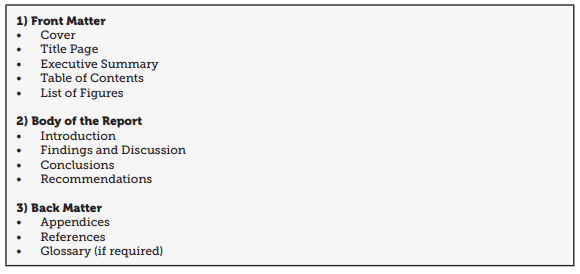
A business report contains the following elements:
1) Title Page: This informs the reader what they’re about to read, and when and by who it was written.
2) Executive Summary: This is the shortened version of a report. It contains the topic, overview of data and recommendations. This is for busy managers and executives who may not have the time to go through the entire report.
3) Table of Contents: For lengthier reports, this section lists the headings and subheadings in chronological order. The page number is mentioned along with the headings and subheadings for easier navigation.
4) Introduction: This section highlights the topics presented in a report. The reader is informed about the purpose of the report, the data collected and why it was collected.
5) Body: The body of a report is where the details come in. Depending on the type of report, this section highlights multiple sets of data and subheadings relevant to the main subject. Data can be presented using pictures, tables, graphs and charts.
6) Conclusion: This is the concluding part of a report. It is used to summarize the content found in the body of a report.
7) Recommendations: The recommendation section is used as a call for action as to what should be done next. It is used to present solutions to issues, answer questions and justify arguments found in a report.
8) References: This section lists the sources of information found in the report. Contact info, links and locations of third-party resources can be found in this part of a business report.
9) Appendices: This is the last section of a business report. Additional documents and information such as a glossary, financial data and transcripts of interviews are listed in the appendix.
To know more check out our detail guide on structure of a business report.
Important Benefits of Business Report for an Organization
Out of all the important characteristics of report writing, the prime one is it being a tool of communication. Reports are used to bridge the gap between different areas of a company.

Other important benefits of business reports are:
Tracks Development: Business reports track growth history, analysis of trends and project details. This progress is tracked over a period of time. Past reports are used as reference points for working on weaknesses and improving the company’s goods and services.
Duty to Stakeholders: The legal fiduciary obligations of a company to its stakeholders and government agencies also rely on written reports. Annual business reports are processed to provide a complete picture of all business activities to the concerned parties.
Audit Trail: Reports record the history of a company’s past activities. Information related to budgets, sales, meetings, etc. is all documented. This helps provide a well-organized record of the company’s transactions for auditing purposes.
Tackling Complex Situations: Different types of reports in communication are used to understand complex situations that arise in a company. These reports are used to implement strategies and offer solutions.
Coordination Among Various Levels of Management: Reports reduce the administrative distance between the three levels of management in a business. These levels are – operative, strategic and coordinative.
Related Reading: Importance of Report Writing In Business Communication
Frequently Asked Questions
Q1. What is the purpose of a business report?
Ans. The purpose of a business report is to communicate data in a clear and concise manner to managers, executives and shareholders. It is a managerial tool used for decision-making, professional advancement and conducting investigations.
Q2. Three types of business reports?
Ans. There are many different types of business reports. Three commonly used ones are – Informational Reports, Analytical Reports and Research Reports.
Q3. What are the types of formal reports?
- Types of Formal Reports are:
- Audit
- Annual Report
- Incident Report
- Situational Report
- Compliance Report
- Inspection Report
- Safety Report



